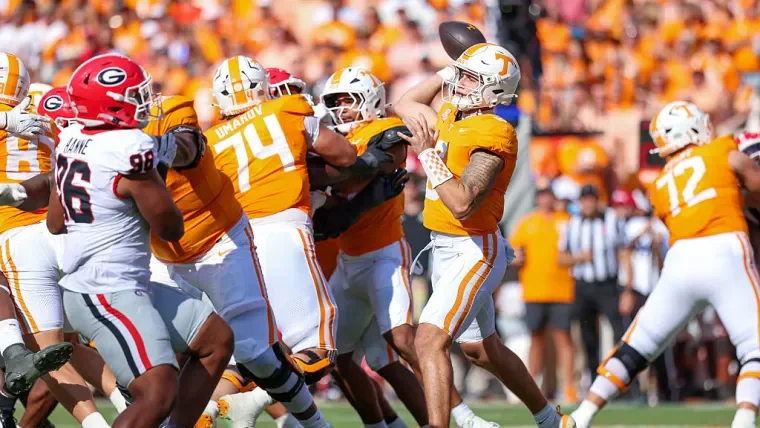Joey Aguilar, QB vs #6 Georgia 2025
Player: Joey Aguilar - QB Tennessee
Height: 6’3”
Weight: 225 lbs
Opponent: #6 Georgia
Season: 2025
Final Stat Line:
24/36, 371 Yards, 4 TDs, 2 INTs
7 Carries, 21 Yards, 1 TD
Film Link: Watch on YouTube
Overview
Aguilar’s tape is a blend of real downfield threat and uneven decision-making. On the plus side, he shows workable play-action rhythm and can create outside structure—sidestepping pressure, rolling left, and throwing accurately on the move. The vertical aggression is there, producing two explosive plays: a deep ball released just before contact and a true jump-ball shot in single coverage that his receiver wins. The flipside is late-down and pressure handling. One deep attempt is forced into double coverage and underthrown for an interception, and the overtime snap devolves into a back-foot heave against a blitz that dies short and nearly becomes a giveaway.
Usage / Alignment: Shotgun and pistol with heavy PA usage; RPO look early; designed QB run in goal-to-go; rollout/throw-on-the-move reps to both sides; vertical shots off PA.
Film Review – Key Plays
Play 1) 14:25 1Q, 1st & 10 - 20 Yard Pass
Shotgun with PA (RPO look); Aguilar sets and throws the slant to the TE on time, it’s secured cleanly, and the TE turns up to add ~10 more. This play shows workable PA rhythm and decisive timing to the middle—ball out before interior traffic can crowd the window, letting the target catch on the move and pick up yards after the catch. It’s a simple read thrown with pace and placement, the kind of on-schedule rep that keeps drives ahead of the sticks.
Play 2) 9:42 1Q, 2nd & 7 - 70 Yard TD Pass
Shotgun, PA; he has time initially, the blitz arrives late, and he launches deep right before he’s hit. The ball is slightly underthrown, but the WR fights through contact, finishes the catch, and takes it roughly 25 more for the TD. Here, we get a look at pocket toughness and vertical aggression; even with the underthrow, the willingness to give his receiver a shot turns pressure into a touchdown rather than a sack or throwaway.
Play 3) 7:37 1Q, 2nd & 7 - 20 Yard Pass
Shotgun, PA; after an initially clean platform, the rush closes. Aguilar sidesteps, rolls left, and throws on the run toward the sideline; it’s caught, and the receiver steps out. This clip underscores Aguilar’s ability to create outside structure—he keeps eyes up through the sidestep, squares enough to place the ball while moving opposite his arm side, and converts a collapsing pocket into a chain-mover without forcing the ball into traffic.
Play 4) 1:10 2Q, 3rd & 4 - Interception
Shotgun; he fades left, loads up, and fires deep into double coverage. The ball is underthrown and intercepted. This is the costly side of his aggression: late-down, field-flipping intent colliding with coverage and poor ball location. Instead of a fresh set of downs, it flips possession—an example where situational awareness could have protected the drive.
Play 5) 0:17 3Q, 2nd & 6 - 55 Yard TD Pass
Shotgun, PA, quick drop; he loads and sends a deep ball into single coverage. The WR goes up, wins the jump ball, and finishes the last stretch for six. This is vertical aggression used properly: identify the one-on-one, trust your guy, and give him a catchable shot downfield.
Play 6) OT, 3rd & 9 - Near-INT (Back-Foot Heave)
Shotgun; the blitz comes immediately, and he throws off his back foot. The ball dies ~10 yards short, and a diving defender nearly picks it. Mechanics and decision-making unravel here—under heat, he chooses a hope ball instead of living to fight 4th down. It’s inches from a giveaway and a clean example of what needs tightening under pressure: base, conviction, or a throwaway, not a dying ball into coverage.
Final Thoughts
Aguilar’s Georgia tape blends legitimate explosive ability with some shaky decision-making. The positives are obvious: workable play-action rhythm, the ability to create outside structure & throw accurately on the move, and vertical aggression that produced two touchdowns. The counterargument is decision-making and mechanics under pressure: forcing a deep ball into double coverage for an interception and a back-foot heave against a blitz in OT that dies short.
Strengths on Display
Play-action rhythm to the middle: Gets the ball out on time to in-breaking routes and lets targets build YAC.
Creation outside structure: Sidesteps pressure, rolls left, and delivers catchable throws on the move.
Vertical aggression with toughness: Will take the downfield shot, including releasing just before contact, and trust his receiver in true one-on-one situations.
Situational strike ability: Identifies and capitalizes on single-coverage chances for field-flipping explosives.
Areas for Improvement
Decision-making under pressure: Don’t force deep shots into double coverage; match aggression to the coverage picture.
Stress behaviors: Under heat, keep the base and platform—no back-foot lobs that die short.
Late-down management: On late downs and in OT, prioritize possession—take the underneath, throw it away, or live for the next snap instead of hero balls.
Window discipline: Avoid locking on early; manage underneath defenders and timing so throws aren’t telegraphed.
